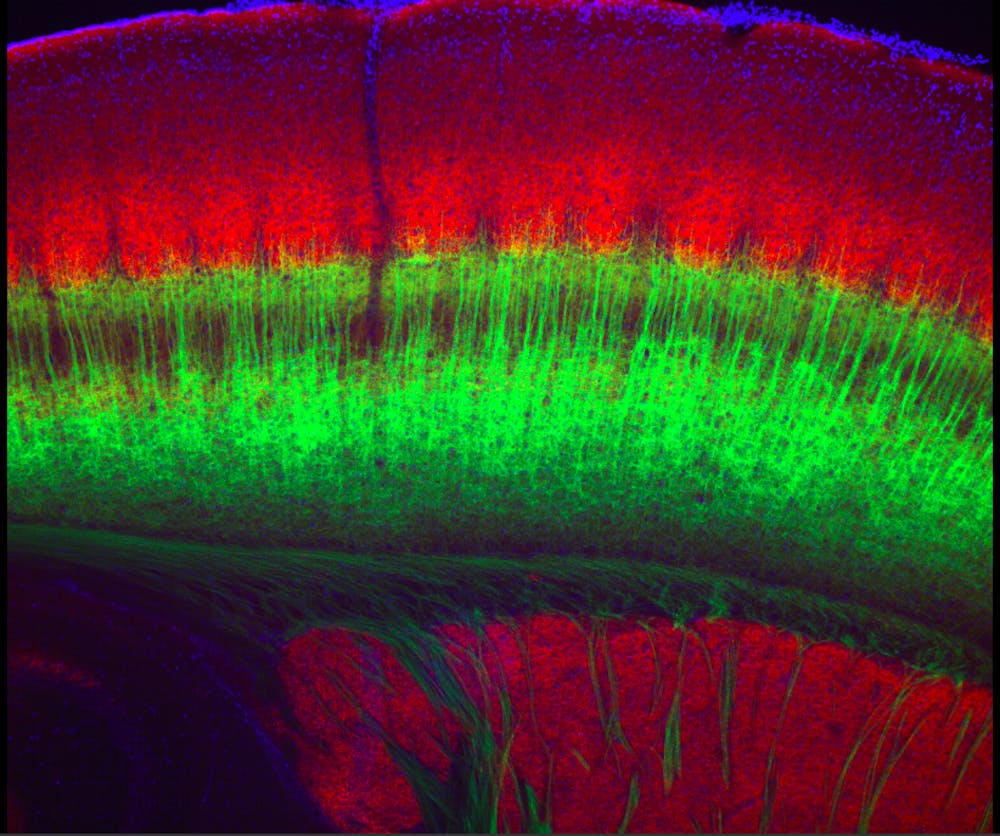A sixth, largely unexplored layer in the cortex was the focus of a recent study by Brown University neuroscientists. The work provides new insight into how the cortex and thalamus communicate about sensation.
The thalamus is a sensory switchboard responsible for relaying information to other areas, according to the Huntington’s Outreach Research Project at Stanford University.
The cortex is “at the top of the brain — literally, but also in a functional sense,” said Barry Connors, an author of the study and professor of neuroscience. It performs the most complex work on neural information, in charge of many abilities that distinguish people from other animals, including the processing of sensory information and memory creation, he added.
The findings, published in the journal Cell Reports, uncovered new communication circuits in the cortex.
For 50 years, neuroscientists have studied mouse whisker barrels, which are neural structures in the cortex that model how the mammalian brain receives sensory information.
Researchers at Brown discovered similar structures two layers beneath the mouse whisker barrels in mice. These structures, known as “infrabarrels,” were found in the sixth layer of the cortex and provide a better picture of the circuitry involved in sensation. They were also shown to have a role in cross-talk between the thalamus and the cortex.
The discovery explores a part of the brain that scientists previously knew “almost nothing” about, said Alison Barth, professor of biological sciences at Carnegie Mellon University, who was unaffiliated with the study. The study allows researchers to infer how information is processed in the layer from looking at the neuronal architecture, anatomical inputs and electrical properties, Barth said.
This new insight on brain circuitry in the cortex helps researchers better understand uniquely human abilities such as language processing and abstract thinking, as well as diseases such as epilepsy and schizophrenia, Connors said.
“By studying the basic circuitry of the brain and sensory systems, we then have a foundation for a better understanding for disease states in which sensory processing is disrupted or communication between cortex and thalamus is disrupted,” said Shane Crandall, lead author and a former Brown postdoctoral student who is currently an assistant professor at Michigan State University.
In general, findings from rodent studies can be applicable to humans, Connors said. While people don’t have barrels in their brains, the details discovered about these structures can form a comprehensive model for areas that process visual or auditory information, or even decision-making and motor control, Barth said.
Scientists previously knew that the thalamus sent information to the cortex, where it was then processed and sent downstream. The study suggests that “the cortex not only receives information from the thalamus during sensation, but actually sends signals to the thalamus to control the amount of information coming back to the cortex,” Crandall said.
The researchers used “cutting-edge, molecular genetic techniques to very carefully isolate one set of neurons in layer six to understand how those neurons connect to each other and how they are connected to other parts of the brain,” Barth said.
Using genetically engineered mice that expressed fluorescent proteins, the researchers found that neurons located within the infrabarrels project from the cortex to the thalamus. They are located directly underneath mouse whisker barrels and arranged in similar structures.
Through optogenetics, a technique where specific neurons are activated or suppressed through pulses of visible light, the researchers found that neurons between the infrabarrels received strong input from the thalamus, though these neurons communicated mainly within the cortex.
“I like to think of neurons in the cerebral cortex as a high school lunchroom: There are hierarchies,” Barth said. Cells communicate, but some initiate conversation and others do not, she explained.
In future experiments, Connors and his team would like to understand why the cortex is talking back to the thalamus. Is it tuning that information — switching it on and off — or transferring it from one place to another? They would also like to address where the cells extend to and how they communicate with each other.





